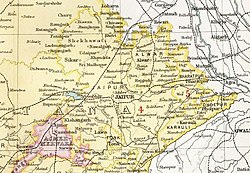Jaipur State
| State of Jaipur जयपुर रियासत |
||||||
| Princely State of British India | ||||||
|
||||||
|
||||||
| Jaipur State in the Imperial Gazetteer of India | ||||||
| Capital | Jaipur | |||||
| Government | Principality (1128–1948) | |||||
| Maharaja of Jaipur | ||||||
| • | 1128 | Dūlaha Rāya(first) | ||||
| • | 1922–1948 | Sawai Man Singh II (last) | ||||
| History | ||||||
| • | Established | 1128 | ||||
| • | Acceded to India | 1949 | ||||
| Area | ||||||
| • | 1931 | 40,407 km2(15,601 sq mi) | ||||
| Population | ||||||
| • | 1931 | 2,631,775 | ||||
| Density | 65.1 /km2 (168.7 /sq mi) | |||||
| Today part of | Rajasthan, India | |||||
Jaipur State was a princely state of India from 1128 to 1948. It was centred on Jaipur town. It existed from the 12th century until Indian Independence in 1947. according to the different periods of history it was also known as Jaipur Kingdom, Amber Kingdom, Dhundhar Kingdom and Kachwaha Kingdom.
Jaipur state was founded in the Dhundhar region. Its predecessor state was the Dhundhar (Dausa) kingdom, founded in 1093 by Duleh Rai, also known as Dulha Rao. Jaipur state was known as Amber between the fourteenth century and 1727. In that year, a new capital was built and named Jayapura, then the kingdom was renamed Jaipur.
The modern-day Kushwaha community, of which the Kachwaha form a part, generally claim descent from Kusha, a son of the mythological Lord Rama. This enables their claim to be of the Suryavansh dynasty but it is a myth of origin developed in the twentieth century. Prior to that time, the various branches that form the Kushwah community - the Kachwahas, Kachhis, Koeris, and Muraos - favoured a connection with Shiva and Shakta, but a direct relationship between Kachwahas and these castes can not be eshtablished. Kacchi, Koeri and Murao can be asserted as those castes who have been degraded from Kshtriya status.
In 1561, the chief at Amber, Bharamail Kachwaha, sought support from Akbar, the Mughal emperor. He was formally recognised as a Raja and was invested into the Mughal nobility in return for him giving his daughter to Akbar's harem. A governor was appointed to oversee Bharamail's territory and a tribute arrangement saw Bharamail given a salaried rank, paid for from a share of the area's revenue. The Rajput practice of giving daughters to the Mughal emperors in return for recognition as nobility and the honour of fighting on behalf of the Empire originated in this arrangement and thus the Mughals were often able to assert their dominance over Rajput chiefs in north India without needing to physically intimidate them, especially after their rout of rulers in Gondwana.
...
Wikipedia



